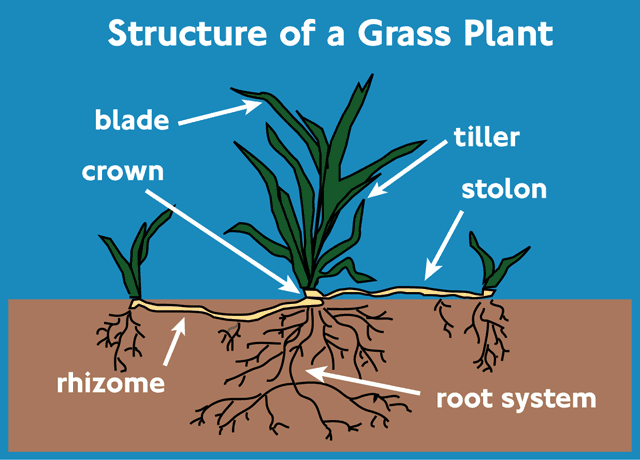Since I did a little bit of an introduction to turf grass botany yesterday by talking about cool and warm season grasses, there has been further interest from readers in exploring turf grass botany.
There’s no better place to start than at the beginning, so today we will look at the basic shoot structure of the grass plant. Of course there is a lot of variation between species in how these structures appear but the following is a broad overview of turf grass plant shoot structures.
Shoot
This is the basic functional unit of the plant and consists of a short stem with leaves appearing alternately from nodes along the stem.
Stem
The stem is the main trunk of the plant that can take the form of a crown, which is a kind of bunched up stem where all of the leaf producing nodes are stacked one on top of the other or of an elongated stem (stolon or rhizome) that grows laterally either on or below the soil surface with widely spaced internodes from which new shoots and roots can appear. Lastly it can appear as a long upright stalk with widely spaced internodes (leaf producing points) ending in an infloresence/flower which is called a culm; more commonly called a seed head. The main functions of the stem are:
- sites of buds where new shoots or roots can be initiated.
- the movement of water, nutrients and food (carbohydrates) between the roots and the leaves.
- storage of food for emergencies such as drought or injury.
Nodes
These are the bulbous points on the stem where leaves, roots or branches of the stem are initiated. These nodes are key to the recovery of turf grass from wear and tear and other natural stresses such as heat and drought, insect and disease injury. They are key structures in determining the recuperative potential of the turf grass plant.
Internode
The internodes are the sections of the stem between nodes and these sections rather than just being the bits between the all important nodes, are key areas of activity in the plant. This is where the translocation (transport) of water, nutrients and already photosynthesised food (carbohydrate) occurs.
A key point to note here is that if you cut through the stem, new growth will be stimulated from the immediately adjacent nodes on each side of the plant to form new shoots or roots depending on their position on the plant. This is why frequent mowing is so important in producing a dense turf.
Leaf
The grass leaf is the part we think of as the blade (although that has a more specific meaning in botany) and grows laterally out of the stem at a node. The leaf consists of an upper blade which is flattened and a basal sheath which encircles the stem at the node from which it arises. The leaf is the key food producing structure of the plant as it contains chlorophyll, the green pigment responsible for the capture of light energy from the sun. The leaf is a hive of food producing activity, being the main site of photosynthesis in the grass plant. It is the leaf that when combined with many thousands of others, forms the turf that we need for bowling.
Blade (leaf)
Rather than referring to the whole leaf, the blade is actually the flattened portion of the leaf furthest from the stem, although in species such as Festuca (Fescues) the flattening is barely perceptible.
Sheath (leaf)
This is the tubular portion of the leaf surrounding or wrapping around the stem at a node. Usually referred to as the basal sheath, it contains some chlorophyll which gives it a green colour.
So that’s the basic structure of the turf grass plant in very brief terms. Next time I will dig a little deeper and look at how grass plants actually grow.
As always, if you have anything to add, observations or questions just add a comment below or drop me a line.
Grass plant image thanks to Wackymacs

